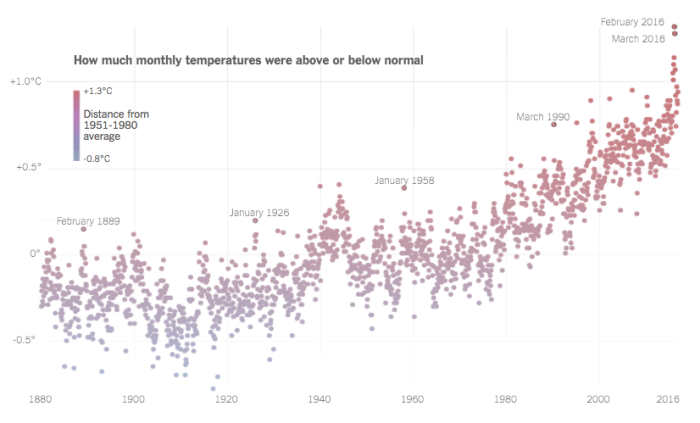Recently, scientists reported that the Earth reached its highest temperature on record in 2016, trouncing a record set only a year earlier, which beat one set in 2014. It is the first time in the modern era of global warming data that temperatures have blown past the previous record three years in a row (below).
In the United States alone there are over 3,500 landfills that emit 20% of dangerous methane gas into the atmosphere. Since 1960, humans have doubled the daily garbage contribution due to our thirst for plastic water bottles. Just last year, Americans used about 50 billion plastic water bottles, with 80% ending up in landfills. This means that 38 billion water bottles or $1 billion worth of recycled materials are wasted every year. Most of the world’s recycling plants cannot afford large industrial spectrometers to sort garbage, and rely on inefficient, expensive, human labor.
While some might doubt climate change, roboticists across the globe are rising to tackle the dullest, dangerous, and possibly the dirtiest job – sorting garbage. In the past year, the waste industry has begun to embrace new software and mechatronic innovations to bring down costs.
A leader in this field is the Finnish company ZenRobotics, which utilizes machine learning, computer vision, and synchronized robotic arms to sort and pick recycled materials from moving conveyor belts. By training its system of recycling stations to use a neural network, the AI autonomously learns the types of materials it needs to quickly pick from real-time data feeds via its connected spectroscopic cameras, 3D laser scanners, and metal sensors. The company released the above movie trailer-like video to introduce its novel approach to the waste management industry.
According to Janica Johansson, ZenRobotics’s Marketing Director, “That means that the robots are able to make autonomous decisions on what to sort out. There is no human involvement in the sorting process, and the robots are not pre-programmed to do anything. One of the benefits of our software [is] that it actually can adapt to the changing waste streams.”
Spanish-based Sadako Technologies is also working on AI-infused garbage sorting systems, just on a smaller scale. Similar to Zen, Sadako uses proprietary algorithms that connect to its own multi-layer neural network system hosted on the Cloud. The deep learning computing platform is able to process and identify recyclable materials in real-time via computer vision sensors. According to Sadako’s website their technology is “outperforming human capabilities.” Sadako’s products are estimated to have a picking cycle of one pick every three seconds, or 20 picks per minute. This equates to 1.8 million picks per year, or up to 200 tons of material. The company is aiming for their robots to replace human pickers in the next few years by dramatically reducing the cost of labor and technology.
According to co-founder, Belén Garnica, “We strongly believe that this work is DDD (dirty, dull and dangerous) and that if robots have to replace any work, this is it.” Ms. Garnica’s co-founder, and brother, Eugenio says,“the only way of being cheaper is avoiding the use of infrared spectroscopy, which is a typical industrial solution in waste plants. We are performing the detection using a normal camera and AI computer vision. Developing this is very complicated. It’s the main challenge of our project: we use a normal camera and we needed to add a lot of intelligence so the camera looks at objects the same way a human does. As people we don’t have infrared spectroscopy in our eyes, we have normal visual capabilities. That’s what we are aiming to do with our AI.”
American-based startup AMP Robotics is targeting the U.S.’s multi-billion dollar garbage addiction. Unlike Zen and Sadako, AMP’s product has yet to be released in even a video demo. Last year, I met AMP at a startup competition that I judged. I saw firsthand their technology that combines computer vision, path planning, and classification. The use of neural networks enables AMP to offer a very inexpensive solution that integrates off-the-shelf robotic hardware and sensors. AMP’s software promises a significant reduction in capital costs and plant efficiency to change the economics of recycling and hopefully reduce our landfills.
Matanya Horowitz, founder of AMP, “We’re using off-the-shelf components — the robots, the sensors — and we’re simply adding our software to it. Unlike a lot of equipment manufacturers, we use a learning system to show the robot what these different things look like.”
Today, in New York City the net cost of recycling a ton of trash is now $300 more than it would cost to bury the trash in a landfill. That adds up to about half the annual budget of the parks department. Industry executives are eagerly awaiting solutions from providers like Zen, Sadako, and AMP. David Steiner, the CEO of Waste Management, the largest recycler in the United States says, “if you believe recycling is good for the planet and that we need to do more of it, then there’s a crisis to confront. Trying to turn garbage into gold costs a lot more than expected.”
According to the US Department of Labor there are close to 400,000 workers within the waste management industry that dispose of the 220 million tons of garbage every year. These jobs are now in the crosshairs of automation, as the only way to make recycling more economical, and accessible, is to reduce the cost of labor. On March 2nd, we will be exploring “The Societal Impact of Robotiics” at our Robot Lab Forum in New York City. We hope you can join us then…






